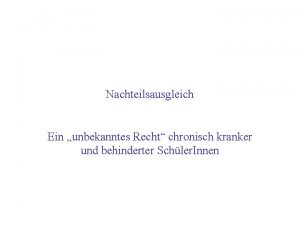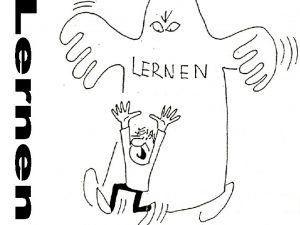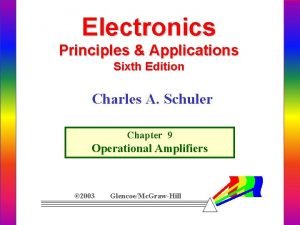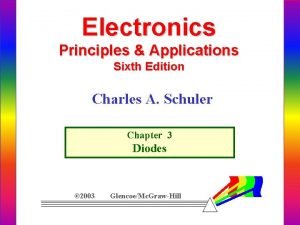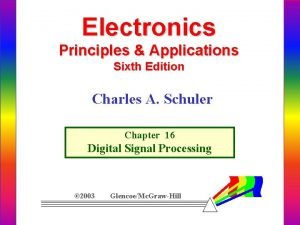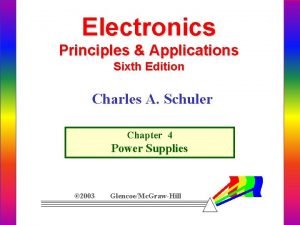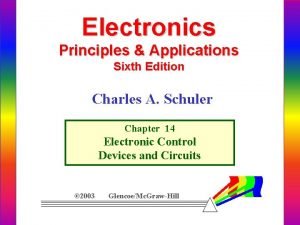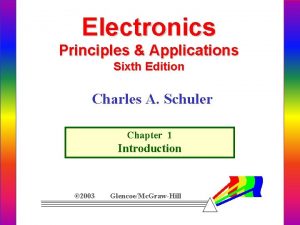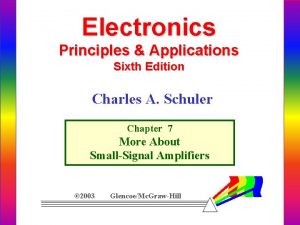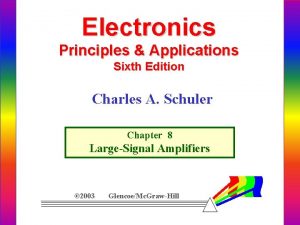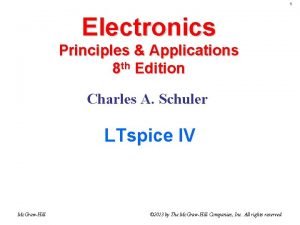Electronics Principles Applications Sixth Edition Charles A Schuler



























- Slides: 27

Electronics Principles & Applications Sixth Edition Charles A. Schuler Chapter 12 Communications © 2003 Glencoe/Mc. Graw-Hill

INTRODUCTION • Modulation and Demodulation • Simple Receivers • Superheterodyne Receivers • Frequency Modulation • Single Sideband • Receiver Troubleshooting

A high-frequency oscillator can launch a radio wave. High frequencies are often called radio frequencies. Oscillator The process of adding information to the radio signal is called modulation.

Radio Frequency (RF) Amplitude Modulation AM = RF x AF + RF Modulator Audio Frequency (AF)

Since the RF carrier frequency is much higher than the modulating frequency, an actual oscilloscope display of AM looks like this: On a spectrum analyzer, AM looks like this:

amplitude Oscilloscope amplitude time f. C = carrier frequency Spectrum Analyzer LSB = f. C - f. AUDIO frequency USB = f. C + f. AUDIO AM produces sum and difference frequencies called sidebands.

+VCC AF f. C = L 1 2 p LC C RF (f. C) An amplitude modulator

AM Quiz The process of placing information on a carrier wave is _____. With AM, the _____ of the carrier wave is controlled or varied. modulation amplitude The oscilloscope displays a graph of _____ versus time. amplitude The spectrum analyzer displays a graph of _____ versus time. frequency A spectrum analyzer display of AM shows a carrier plus two _____. sidebands

AM in Diode Audio out This capacitor approaches a short circuit at the carrier frequency. An AM Detector

Antenna A very basic AM receiver Transmitter Diode Headphones

gain A practical receiver needs tuned amplifiers to provide selectivity and sensitivity. frequency

Antenna Mixer Oscillator It’s too difficult to simultaneously tune several circuits. The IF amplifier is permanently tuned to one frequency. IF amplifier Detector Audio The desired station frequency is mixed to the IF frequency. Carrier and IF passband sidebands

Frequency mixing is also called converting or heterodyning. Receivers like this are known as superheterodyne types. Antenna Mixer Oscillator IF amplifier Detector This is called the local oscillator and it is tuned above the station frequency by an amount equal to the IF frequency.

f. STATION = 1020 k. Hz Some typical frequencies: f. IF = 455 k. Hz Mixer Oscillator IF amplifier Detector f. LO = 1475 k. Hz Note: The two inputs to the mixer have a difference of 455 k. Hz.

Superheterodyne receivers can also respond to the image frequency. f. STATION = 1020 k. Hz f. IMAGE = 1930 k. Hz A tuned circuit before the mixer is required. f. IF = 455 k. Hz IF amplifier Mixer (1930 - 1475 = 455) Oscillator f. LO = 1475 k. Hz Detector

Receiver Quiz Recovering the information from a modulated signal is called _____. AM detection is often accomplished with a _____ rectifier. detection diode Radio receivers employ tuned amplifiers to provide sensitivity and _____. selectivity Superheterodyne receivers convert each signal to an _____ frequency. intermediate A superhet can respond to one additional frequency called the _____. image

Frequency Modulation One way to accomplish this is to use a varicap diode in the oscillator tank circuit. RF Oscillator Audio Frequency (AF) The audio signal changes the varicap bias and the resonant frequency of the tank circuit.

On a spectrum analyzer, FM shows more sidebands than AM. Lower sidebands f. C Upper sidebands FM usually requires more bandwidth than AM.

Noise is always a problem in any communication system. FM has an advantage over AM since it offers better noise rejection. FM signal plus noise Noise removed LIMITER Modulation preserved An FM receiver can use an amplitude limiter to remove noise. An AM receiver cannot since the modulation would be defeated.

Radio Frequency (RF) DSBSC Modulation DSBSC = RF x AF Balanced modulator Audio Frequency (AF)

Radio Frequency (RF) DSBSC Modulation Spectrum analyzer Balanced modulator LSB USB No carrier Audio Frequency (AF)

Since the sidebands are redundant, one can be filtered out to decrease bandwidth. Balanced modulator Bandpass filter The lower sideband is not in the passband. SSBSC Only the upper sideband is transmitted. frequency

A superheterodyne SSB receiver requires a second oscillator to replace the missing carrier. Mixer Oscillator IF amplifier Detector Oscillator

Bluetooth Range: 10 to 100 meters Power: 1 to 100 m. W Sensitivity: 0. 1 n. W (-70 d. Bm) Frequency: 2. 4 GHz Data rate: 1 Mbit/s

Receiver Troubleshooting • Signal injection is standard practice. • Both AF and RF signal generators may be required. • Some receivers may require adjustments of their tuned circuits. This is called alignment.

FM and SSB Quiz With FM, amplitude noise can be removed with a _____. limiter FM needs more bandwidth than AM since there are more _____. sidebands A balanced modulator produces sidebands but no _____. carrier In SSB, one of the sidebands can be eliminated by using a _____. filter SSB demodulation requires an oscillator to replace the missing _____. carrier

INTRODUCTION • Modulation and Demodulation • Simple Receivers • Superheterodyne Receivers • Frequency Modulation • Single Sideband • Receiver Troubleshooting
 Principles of economics sixth edition
Principles of economics sixth edition Inicum
Inicum Rubber baby buggy bumpers tongue twister lyrics
Rubber baby buggy bumpers tongue twister lyrics Biochemistry sixth edition
Biochemistry sixth edition Computer architecture a quantitative approach sixth edition
Computer architecture a quantitative approach sixth edition Automotive technology principles diagnosis and service
Automotive technology principles diagnosis and service Automotive technology sixth edition
Automotive technology sixth edition Citation sample pdf
Citation sample pdf Computer architecture a quantitative approach 6th
Computer architecture a quantitative approach 6th Precalculus sixth edition
Precalculus sixth edition Computer architecture a quantitative approach sixth edition
Computer architecture a quantitative approach sixth edition Heat pipes for electronics cooling applications
Heat pipes for electronics cooling applications Power electronics circuits devices and applications
Power electronics circuits devices and applications Electronics fundamentals circuits devices and applications
Electronics fundamentals circuits devices and applications Angstfragebogen für schüler
Angstfragebogen für schüler Chiara schuler
Chiara schuler Sachtexte beispiele klasse 5
Sachtexte beispiele klasse 5 Schüler lehrer beziehung
Schüler lehrer beziehung Nachteilsausgleich chronisch kranke schüler
Nachteilsausgleich chronisch kranke schüler Schuler ágnes
Schuler ágnes Tempus gedicht
Tempus gedicht Lerntipps für schüler gymnasium
Lerntipps für schüler gymnasium Hallo liebe schüler
Hallo liebe schüler Scook
Scook Hallo liebe schüler
Hallo liebe schüler Geburtstagsgedicht heinz erhardt
Geburtstagsgedicht heinz erhardt Lernstrategien für schüler arbeitsblatt
Lernstrategien für schüler arbeitsblatt Schuler vin
Schuler vin


















